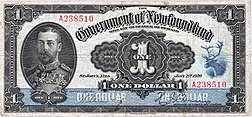Newfoundland dollar
| Newfoundland dollar | |
|---|---|
|
Dollar de Terre-Neuve (French) Dollar Talaimh an Éisc (Irish) |
|

$1
|
|
| Denominations | |
| Subunit | |
| 1/100 | cent |
| Symbol | $ or NF$ |
| cent | ¢ |
| Banknotes | 25¢, 40¢, 50¢, 80¢, $1, $2, $5, $10, $20, $50 |
| Coins | 1¢, 5¢, 10¢, 20¢, 25¢, 50¢, $2 |
| Demographics | |
| User(s) |
|
| Issuance | |
| Central bank | Department of Finance and Customs |
|
This infobox shows the latest status before this currency was rendered obsolete.
|
|
The dollar was the currency of the colony and Dominion of Newfoundland from 1865 until 1949, when Newfoundland became a province of Canada. It was subdivided into 100 cents.
In 1865 Newfoundland adopted the gold standard, and the dollar replaced the pound at a rate of 1 dollar = 4 shillings 2 pence (50 pence) sterling, slightly higher than the Canadian dollar (worth 4s 1.3d). The significance of this rating was that two cents would be equal to one penny sterling. It was seen as a compromise between adopting the British system or the American system. It also had the effect of aligning the Newfoundland unit to the dollar unit in the British Eastern Caribbean colonies. The West Indian dollar was directly descended from the Spanish Dollar (Pieces of Eight). Newfoundland was unique in the British Empire in that it was the only part to introduce its own gold coin in conjunction with its gold standard. Newfoundland two dollar coins were minted intermittently until the Newfoundland banking crash of 1894. In 1895, following this banking crisis, the Canadian banks moved into Newfoundland and the value of the Newfoundland dollar was adjusted to set it equal to the Canadian dollar, a devaluation of 1.4%. The Newfoundland dollar was replaced by the Canadian dollar at par when Newfoundland joined Canada in 1949.
The other British North American colonies adopted the American unit around the same time that Newfoundland adopted the West Indian unit. The small disparity between the American unit and the West Indian unit was because in 1792, Alexander Hamilton at the US treasury took an average weight of worn Spanish Dollars to be the new American unit of currency.
The Newfoundland decimal coinage would have corresponded exactly to the dollar unit that was used in another British colony in South America. British Guiana used accounts based on the Spanish dollar, but these accounts were used in conjunction with the sterling coinage.
...
Wikipedia
